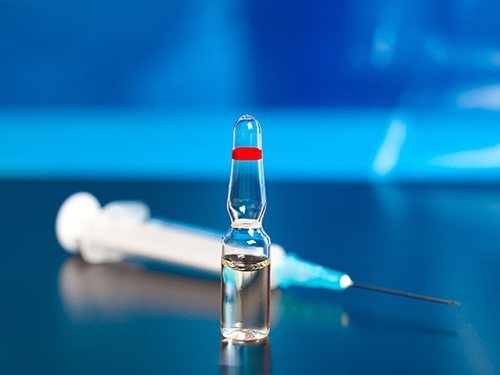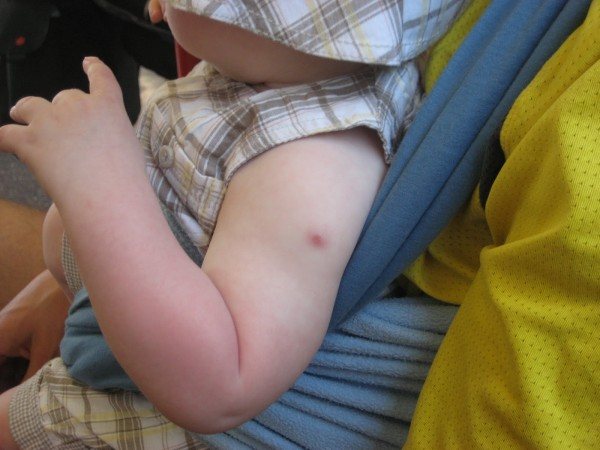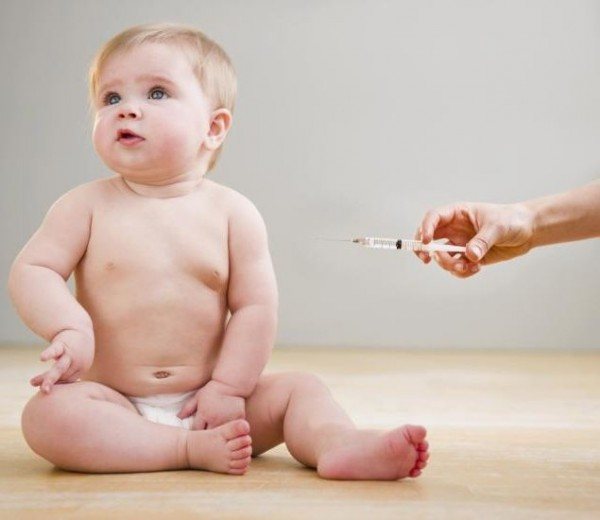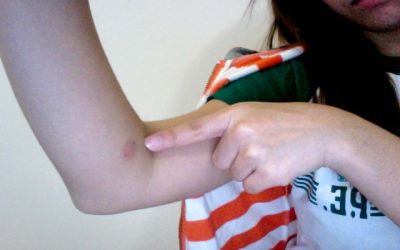Outline of the article: 1. Preparation for vaccination 2. Requirements for medical personnel and vaccination site 3. Requirements for tools and materials 4. Vaccine dilution technique 5. How is vaccination done? 6. Observation of the patient BCG (Bacillus Calmette—Guérin) is prepared from artificially grown bovine tubercle bacilli. This bacillus does not pose a danger to humans, as it is weakened by cultivation in an artificial environment. The effectiveness of the vaccine and its safety directly depend on how accurately the BCG vaccination technique is followed.
Requirements for tools and materials
All ampoules must be carefully inspected. Damaged ampoules, as well as vaccines whose appearance does not correspond to the norm, are not allowed for use: only a white or creamy powdered tablet with a smooth surface. Expired ampoules are disposed of. The ampoules with the solvent should also be checked: sodium chloride should normally be colorless, transparent and free of impurities.

The BCG vaccine is administered with a tuberculin syringe and a needle No. 0415 with a short bevel. The preparation of the vaccination solution is carried out using a 2 ml syringe and a needle No. 085 for intramuscular injections. All tools should be disposable, preferably self-destructive.
All sterile dressings should be stored in closed boxes.
When conducting vaccinations, the nurse must always use a mask and rubber gloves, which should be changed after each patient. One ampoule contains material for several vaccinations. For short-term proper storage of the opened and diluted vaccine, a cylinder-shaped bag made of black, light-opaque paper is used.
What kind of vaccine is this?
You understand that BCG vaccination is necessary to protect the body from tuberculosis, and it is created from a strain of weakened tuberculosis bacillus. The microorganism is safe for humans, because it is grown in a special way under artificial conditions.
The main task of the BCG vaccine is the prevention of tuberculosis. Vaccination cannot guarantee protection against infection, but why is it done? It prevents the transformation of a latent infection into an open form, and also prevents the development of complications:
- damage to the bone apparatus;
- tuberculous meningitis;
- lung infection.
What is BCG and what the vaccination helps with is clear, but what is included in it, when is it done and what complications should you remember?
Vaccine dilution technique
- Before vaccination, the nurse should once again study the instructions for the vaccine and inspect the ampoules and packaged syringes.
- Ampoules are treated with a 70% alcohol solution at each stage of opening: before and after filing the neck. The ampoules should be broken using sterile wipes.
- The solvent is injected with a two-gram syringe, carefully along the wall of the ampoule. For the correct preparation of BCG, the following calculation is used: 2 ml of solvent for an ampoule with 20 doses and 1 ml for an ampoule with 10 doses.
- To properly dissolve the vaccine, the suspension must be drawn back into the syringe and mixed with rotational movements of the piston. Then the solution with the vaccine is reintroduced into the ampoule, which must be kept in a black paper bag covered with a sterile napkin until completely used. The finished vaccine can be stored for no more than two hours.
- After diluting the vaccine, the two-gram syringe and needle are placed in a disinfectant solution for further disposal.

Features of the disease tuberculosis
Infection occurs with a bacterium called Koch (lat. Mycobacterium tuberculosis). It mainly damages the lungs, but can settle in any part of the body. People with weak immune systems and children are primarily susceptible to the disease. The disease progresses unnoticed or in a severe form.
Infection occurs through airborne droplets: sneezing, coughing, shaking hands. Easily transmitted in general everyday life. Infection can have a long incubation period until a favorable environment for awakening is created (the immune system weakens, the person gets a serious illness, pregnancy). The patient can live peacefully for years and not realize that he is infected.

No cure for tuberculosis has been invented. Existing pharmacological agents will help bring the disease into stable remission.
The price for a small course of drugs starts from 2500 rubles. Therefore, it is so important to carry out preventive vaccinations of children from birth, since it is difficult to say how many sick people are around a particular child.
How is the vaccination done?
The BCG technique is quite simple, but requires utmost attention.
- For one vaccination, 0.2 ml or two doses are enough, which are drawn into a tuberculin syringe.
- To remove air from the syringe, release one dose into a sterile swab. After this, the tampon is disposed of in a disinfectant solution.
- The injection site is treated with a 70% alcohol solution twice. The vaccine is injected into the upper outer surface of the upper arm.
- The method of administering the BCG vaccine requires caution: in no case intramuscularly or under the skin - only intradermally. In this case, a “button” of no more than 6 mm is formed, which disappears after half an hour. The needle is inserted with the cut up.
- The skin must not be processed after removing the needle!
- The tuberculin syringe and needle are placed in a disinfectant solution for further disposal.
- Patients should know not only how BCG is done, but also the rules of conduct after vaccination. Nevertheless, each patient must be warned not to treat the injection site with disinfectants or apply bandages.
- In the presence of the patient, all necessary entries are made: in the registration log, in the medical record, in certificates. The nurse indicates the date and time of vaccination, the patient’s age, as well as all information about the vaccine: expiration dates, series, manufacturer’s data. Syringes are also disposed of in the presence of the patient.
How many times in my life should I get the BCG vaccine?
To begin with, it should be noted that BCG is, first of all, a drug that protects the child’s body from tuberculosis bacteria. That is, we can conclude that vaccination is very important and mandatory for everyone. In most cases, the drug does not pose a danger to the baby, so parents should not be afraid to vaccinate their child.
As a rule, the BCG vaccine is administered intradermally into the child’s body 3 times during a lifetime. The first vaccination is called the main one and is given to all babies in maternity hospitals. Further, repeated administration of the drug is called revaccination, but it will be written about a little below.

So, as already mentioned, this vaccine is given in the maternity hospital. To be more precise, as a rule, a baby is given an injection with a vaccine on the fourth day of life. It is worth noting that such a rush is due to the fact that the baby’s body is practically not protected from various bacteria, including Koch’s bacillus. In our country, the likelihood of contracting this disease in childhood is very high, so every child must be insured. It’s not even worth describing how dangerous tuberculosis is for newborns, because the likelihood of a baby surviving this disease is quite low.
It is worth noting that if the baby has any contraindications to this vaccine, then vaccination may be postponed.
Thus, the answer to the question of how many times BCG is given is quite simple. During a person’s entire life, the drug is administered only 3 times (the first, on the 4th day of the baby’s life).
Tuberculosis vaccine
The vaccine against tuberculosis is called BCG. The name is due to the scientist who discovered Koch's bacillus Genera. In 1920, a scientist was able to develop a weakened form of the tuberculosis bacterium using an artificially created, harmful environment. A weakened bacterium cannot provoke a disease, but it does form immunity.

Modern vaccines against tuberculosis consist of artificially bred, weakened Mycobacterium bovis bacteria. Their structure is close to the human strain, this helps the body produce the necessary antibodies to tuberculosis.
Of all the known vaccines, BCG is the crudest and most poorly effective, but an alternative to it has not yet been invented. And no one will be able to answer how many years will come.
Is vaccination effective?
There are several forms of the disease. Severe cases include miliary tuberculosis. This form mainly affects children under 5–6 years of age. BCG is quite effective against this form. The more common and milder form of the disease is infiltrative. Vaccination is less effective against it.
The cumulative effectiveness of BCG is about 80%. For this reason, in developed countries, injections are given to children from risky environments: those with weakened immune systems, those born to infected parents, and those who have household contact with a sick person. This information is often used by groups of parents who oppose BCG vaccination. But it is necessary to understand that this attitude towards vaccination is quite twofold. A number of factors indicate vaccination:
- Vaccination protects only in 80% of cases of infection, but a larger percentage relates to infection with a severe form of the disease. Mostly small children suffer, in whom the disease often ends in death.
- Medicines do not cure the disease, but only control the process of organ damage. They are poorly accepted by the body and there are more side effects from them than from BCG.
- In developed countries, where the BCG vaccination was removed from the preventive vaccination calendar, since it is mainly the elderly who get sick there. Their epidemiological threshold is low. In Russia, where the population is several times larger and living conditions are worse, at the end of 2014, 167,000 patients were registered, of which 80,000 were young children. The highest incidence rates are among 15–40 year olds. In such conditions, it is difficult to identify a specific risk group, since most of the population is infected.
Infection after BCG
There are known cases of infection of children up to a month after vaccination with BCG in the amount of 1 per 1 million vaccinated. But patients are seriously ill and 90% of cases end in death.

Scientists have proven that infection during vaccination does not occur due to the fault of the vaccine. It’s just that the child, up to a month old, had genetic changes and congenital low immunity. Another question is, why didn’t the doctors notice this before the vaccination?
If after the BCG vaccination signs appear:
- heat;
- weight began to drop sharply;
- I lost my appetite.
You should immediately run with the baby to specialists.
Do not self-medicate, this will only make the situation worse, as precious time will be lost.
Doctors are unable to protect a baby from tuberculosis for up to a month using other methods, so it is worth getting a BCG vaccination. And in order to protect your child from harmful consequences, make sure that a high-quality examination of the baby is performed before vaccination. Ask your doctor what vaccine will be administered and how it was stored and transported. These simple methods will help save the child and BCG vaccination will not cause problems. And there will be no questions about why BCG is needed.
Republished by Blog Post Promoter
WE ADVISE YOU TO READ:

The child has a large Mantoux: how is this possible and what to do about it
Previous article

BCG pros and cons - doubts caused by complications after BCG vaccination
Next article











